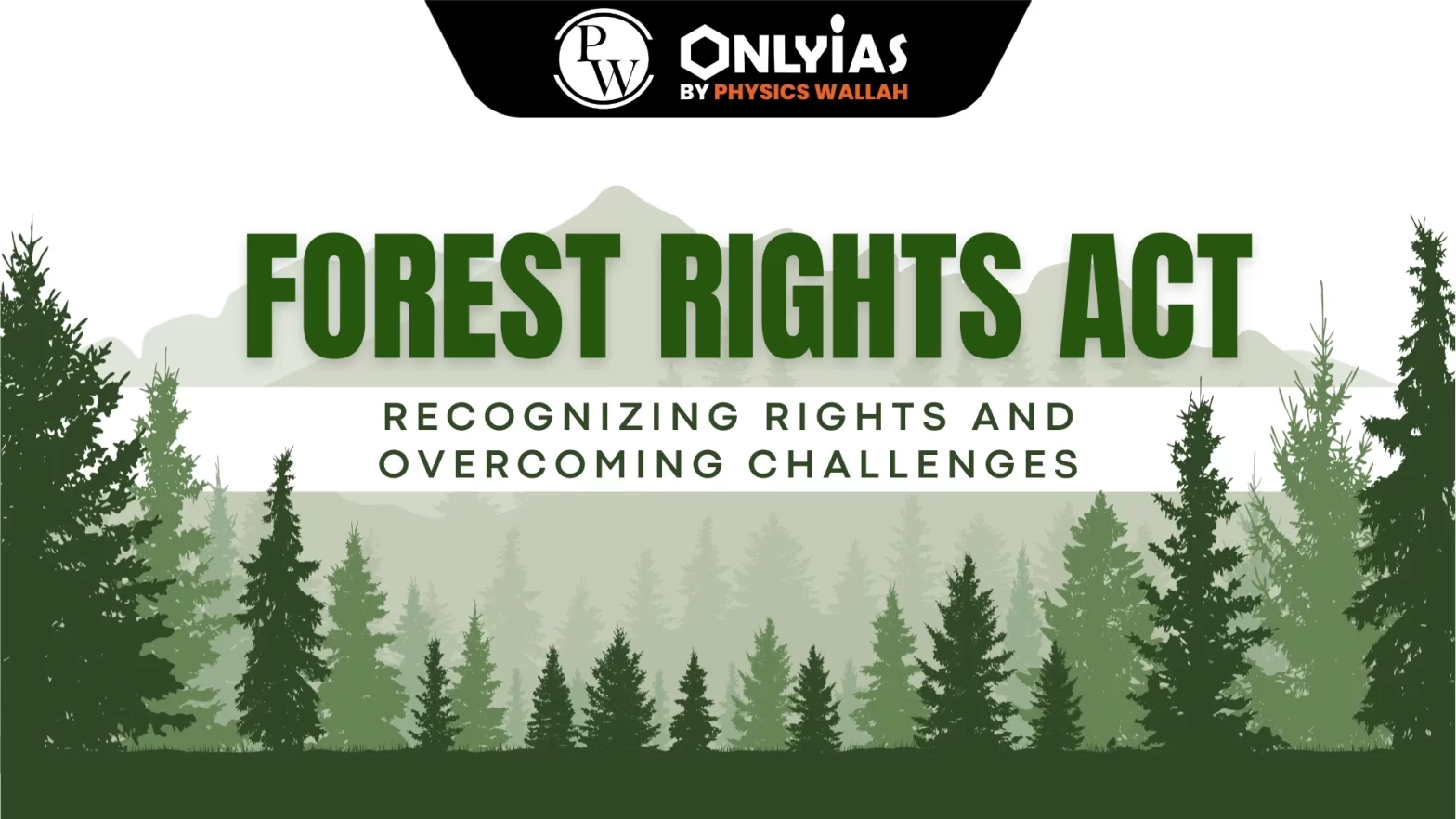Context: This article is based on an Editorial “An uphill struggle to grow the Forest Rights Act” which was published in the Hindu. This article expresses concerns over the implementation of the Scheduled Tribes and Other Traditional Forest Dwellers (Recognition of Forest Rights) Act that was enacted even 17 years earlier.
| Relevancy for Prelims: Scheduled Tribes and Other Traditional Forest Dwellers (Recognition of Forest Rights) Act, Wildlife (Protection) Act 1972, and the Forest (Conservation) Act 1980 (FCA).
Relevancy for Mains: Forest Rights Act 2006, its Significance, Challenges and the Way Forward. |
About Forest Rights Act or the Scheduled Tribes and Other Traditional Forest Dwellers (Recognition of Forest Rights) Act
- Common Name: It is commonly known as the Forest Rights Act, or FRA.
- Significance: It marks a watershed in India’s socio-environmental legislation, as it attempts to resolve the issue of forest encroachments and to create a much more democratic, bottom-up forest governance.
Impact of Colonisation: It resulted in a massive disruption of their traditional rights.
- False Idea of Eminent Domain: It means that the ruler always owns all property, the 1878 (colonial) Indian Forest Act was passed and the takeover of India’s forests began.
- Establishment of the Imperial Forest Department: It was also tasked with protecting ‘state’ property against local communities.
- Ban on Shifting Cultivation as forests were seen as primarily a timber resource.
- Incomplete and biased so-called survey and settlement of agricultural lands.
- Creation of Forest Villages to ensure labor for forestry operations.
- Forests were now state property, all access to forest produce was limited, temporary and chargeable, and always at the mercy of the forest bureaucracy.
- Sudden modification or withdrawal of any concessions to local livelihood needs at any time.
- No rights to manage the forests by locals even where access was permitted.
Impact of hurry Assimilation of Princely States and Zamindari Estates: The forest areas were declared state property and hence legitimate residents and cultivators became ‘encroachers’.
- Unregularised initiatives to meet the needs of a growing population.
- Encroachment of forests as communities displaced by dams were not given alternative lands.
Impact of the Wildlife (Protection) Act 1972 and the Forest (Conservation) Act 1980 (FCA): Lakhs of communities were forcibly resettled without considering the views or consent of local communities and they were not adequately compensated for the impact on their livelihoods.
Must Read: Forests In India: Biodiversity, Types, And Conservation
Forest Rights Act: Significance
- Acknowledgement of Injustices: It acknowledges all the historical injustices.
- Address to the Issue of Encroachments: By recognizing individual forest rights (IFRs) to continue habitation and cultivation or other activities before December 2005.
- Recognising the Rights of Village Communities: To access and use forests, to own and sell minor forest produce, and to manage forests within their customary boundaries.
- Ensuring Decentralized Forest Governance: By linking management authority.
- A Democratic Procedure for Identification: It is about whether and where wildlife conservation may require curtailing or extinguishing community rights.
- Privileges of Community Rights: The Forest Rights Act translates ipso facto into the community having a say in, if not veto over, any diversion of that forest and a right to compensation if diverted.
- Its reaffirmation by the Supreme Court: In the Niyamgiri case.
- Although the Forest Conservation Rules 2022 and FCA Amendment 2023 seek to bypass this right, States can still put in place such consent mechanisms.
Forest Rights Act: Challenges
- Misinterpretation of the Act: Most States focused solely on individual rights and projected the Act as an ‘encroachment regularization’ scheme. Some even encouraged illegal new cultivation.
- Shabbily Recognition of IFRs: Due to compromised Forest Department resistance, the apathy and ignorance of other departments, and misuse of technology.
- Hardship in Claim-Filing: Claimants faced hardship during claim-filing, subjected to faulty and non-transparent rejections and arbitrary partial recognition.
- Imposition of absurd Digital Processes: In areas with poor connectivity and literacy, such as the VanMitra software in Madhya Pradesh, is just a continuation of injustice.
- Non-Recognition to the CFR: These are easy targets for ‘voluntary rehabilitation’, and forests can be handed over for mining or dams without community consent. As per estimations, 70%-90% of the forests in central India should be under CFRs.
- The Forest Rights Act implementation is extremely slow. Only Maharashtra, Odisha, and Chhattisgarh recognised the CFRs, and only Maharashtra has enabled their activation.
- No Proper Recognition: Many departments and political representatives can only visualize forest-dwellers as beneficiaries, not as autonomous users and managers of their own forests.
Way Forward
Political leaders, bureaucrats, environmentalists, and all stakeholders need to appreciate the spirit and the intent of the Forest Rights Act. There is also a need for comprehensive recognition and awareness of both individual and community forest rights by all and its proper implementation.
Conclusion:
Effective implementation of the Forest Rights Act requires a collective understanding and commitment from all stakeholders to recognize and uphold both individual and community forest rights, fostering a more inclusive and sustainable approach to forest governance in India.
| Prelims Question (2018)
Consider the following statements:
1. The definition of “Critical Wildlife Habitat” is incorporated in the Forest Rights Act, 2006.
2. For the first time in India, Baigas have been given Habitat Rights.
3. Union Ministry of Environment, Forest and Climate Change officially decides and declares Habitat Rights for Primitive and Vulnerable Tribal Groups in any part of India.
Which of the statements given above is/are correct?
(a) 1 and 2 only
(b) 2 and 3 only
(c) 3 only (d) 1, 2 and 3
Ans: (a) |
![]() 18 Dec 2023
18 Dec 2023

